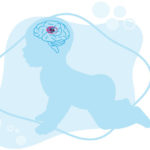Infantile spasms: Speeding referrals for all infants

Infantile epileptic spasms syndrome (IESS), often called infantile spasms, is the most common form of epilepsy seen during infancy. Prompt diagnosis and referral to a neurologist are essential.
Infantile spasms can present subtly, and research indicates that diagnosis is often delayed. Additionally, infants are especially likely to experience delays in referral to a neurologist if their families are from historically marginalized racial/ethnic backgrounds. A new open-access training module for front-line providers from OPENPediatrics, an online learning community launched by Boston Children’s Hospital, aims to change that.
Knowing the signs of IESS
The free, publicly accessible Infantile Spasms curriculum includes short lectures and videos illustrating infantile spasms to help pediatric providers identify IESS and ensure prompt treatment. Through self-assessments at the end of each chapter, clinicians can test their diagnostic skills and hone their instincts. A few key takeaways:
- Infantile spasms can be challenging to distinguish from normal movements. While classic spasms include jerking of the neck, trunk, and extremities, some signs are very subtle, such as eyerolls or head-drops. IESS can also sometimes develop after infancy. Maintain a high index of suspicion.
- Up to a third of parents may not mention abnormal movements to their primary care providers, but instead report behavior changes or developmental concerns. Providers may need to ask these parents about spasms directly. If possible, providers can have parents take videos of their infants to help establish a diagnosis.
- Groups at special risk for IESS include children with tuberous sclerosis complex, Trisomy 21, hypoxic ischemic injury, perinatal stroke, brain malformations, and other genetic conditions. However, many children with IESS will have no known prior neurologic history.
Addressing health care inequities in IESS
A national study in 2022 found that Black children and children with public insurance are less likely to receive a standard treatment course for infantile epileptic spasms as compared with white children and children with private insurance.
That prompted Boston Children’s neurology fellow Christina Briscoe Abath, MD, and her mentor, Chellamani Harini, MD, to take a closer look at care for infantile spasms at Boston Children’s, which took part in the national study.
“We needed to know if children at our center were getting the appropriate treatment for IESS based on their race or ethnicity, so we could promptly address it if so,” Briscoe Abath says.
The study, published in the journal Epilepsia, identified 100 children at Boston Children’s with new-onset IESS diagnosed between 2019 and 2022. The researchers found that children with Black, Indigenous, and People of Color (BIPOC) parents or guardians were more likely to experience delays of more than seven days in referral from primary care to a neurologist, as compared with non-Hispanic white children. This was true even after controlling for median household income, language, distance from the hospital, and clinical factors.
These findings were the motivation behind the OPENPediatrics educational module. Briscoe Abath, Harini, and the other members of the Boston Children’s Infantile Spasm Program, including Stephanie Donatelli, MD, Meghann Soby, MSW, Chris Ryan, MSW, and David N. Williams, PhD, collaborated with OPENPediatrics to develop the module. They received funding from a Pediatric Health Equity Grant from Boston Children’s Office of Health Equity and Inclusion.
Critical to the module’s success, several families contributed photos and videos of their children to demonstrate the wide range of how IESS can present. Based on the research, the module also invites clinicians to consider the reasons for inequities in the evaluation of IESS and how they might act to decrease the disparities.
A voice for families
The multidisciplinary team formed from this initiative continues to meet every other week and is conducting a qualitative research study to uncover the root causes of care inequities. The findings will be used to improve systems of care through quality improvement methodology.
When she joins the Boston Children’s faculty next year, Briscoe Abath hopes to incorporate caregivers from historically marginalized backgrounds into her research. A member of the Neuroscience Family Advisory Council, she also hopes to build a community-based research team to address issues of equity.
There are plans to expand this work to other sites together with the Pediatric Epilepsy Research Consortium. Briscoe Abath and her colleagues are also working with the Infantile Spasms Action Network to raise awareness at the national level.
“We have a moral imperative to address inequities in care affecting children with IESS,” says Briscoe Abath. “We need to work together with families affected by IESS to better understand how to address inequities effectively and meaningfully.”
Take the Infantile Spasms course on OPENPediatrics and learn more about the Epilepsy Center.
Related Posts :
-

Bringing equity to genomic sequencing in newborns: BabySeq 2.0
Today, nearly 900 disorders caused by a single gene are known to be treatable. Yet the recommended “heel stick” testing for ...
-

Clinical trials in children: Is there racial equity?
The treatments and interventions used in medicine are often based on the results of clinical trials. But trials involving adults ...
-

Tuber locations associated with infantile spasms map to a common brain network
About half of all babies with tuberous sclerosis complex (TSC) develop infantile spasms, a type of epilepsy that can have ...
-

Writing the book on infantile spasms: Charlotte’s story
When Charlotte, 3, developed infantile spasms last year, her parents, Kate and Brett, entered a world they didn’t know how ...





